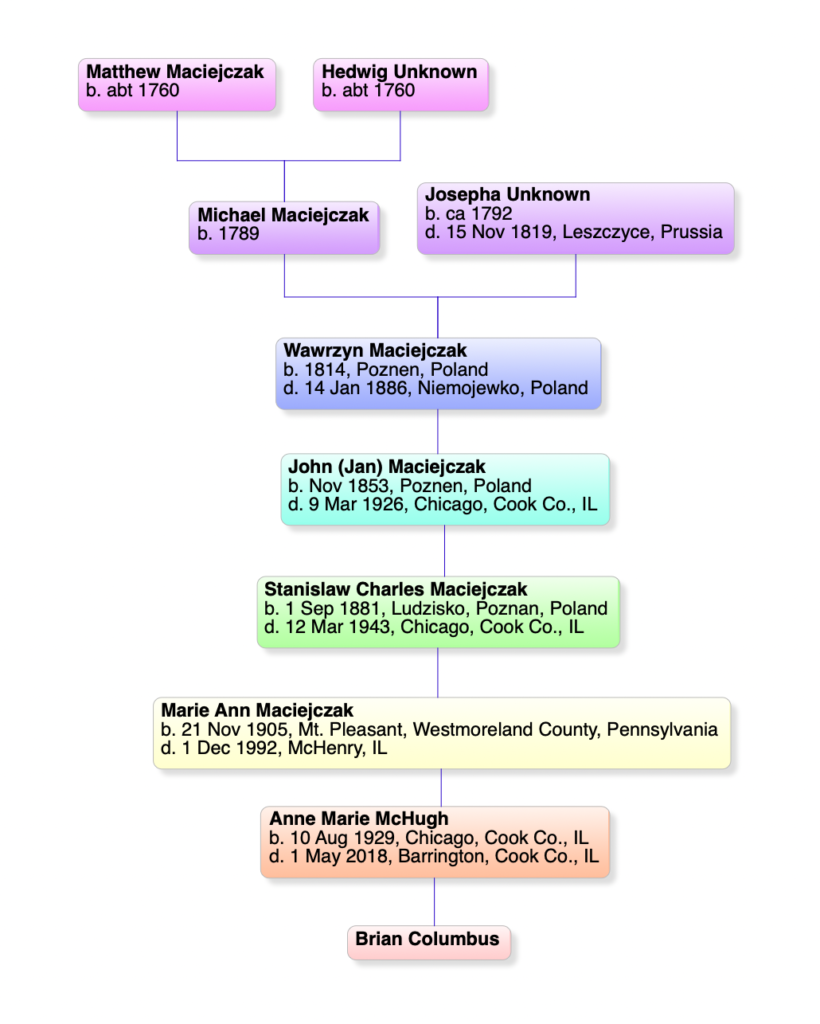I’ve spent a little of my Christmas break dabbling in some research. I tend to pick up an old thread of an idea or revisit some online archives and wander through the information for a few hours at a time, which is what I did this week with some online records at https://geneteka.genealodzy.pl. Thankfully they have an English version of their site, but the records are mostly in Latin, anyway, and I’ve seen enough to get by. Plus there’s Google’s translation site.
The other day I came across a mystery related to some other Polish history I’d discovered recently, and either my research had gone off the tracks or I’d come across an illegitimate scandal.
Earlier this fall I’d written about getting a number of birth and death records for my Polish line, and I’ve written about discovering where the Maciejczak family came from. That post talks about getting back to some GGGG-Grandparents, including Michael Maciejczak and Marianna Kesowna. Now I wanted to explore these lives a bit more.
According to my info, Michael Maciejczak and Marianna Kesowna were the parents of Wawrzyn (Lawrence) Maciejczak, my GGG-Grandfather, born in 1814. I found that he had two sisters, Agatha and Frances, born in 1821 and 1828. I was struck by the age differences, although a fourteen-year spread in a family is not unusual, and it made me think that Wawrzyn was likely one the oldest. I started hunting for a marriage record around 1812, but couldn’t find one.
I did, however, find one from 1821, which matched an index record I had found before, but put in my “questionable” pile, since it was 7 years after Wawrzyn was born.

The location was right, and the names were right because they matched the parental names found with Wawrzyn’s marriage and even the ages sort of made sense that they might have a 7-year-old child. At first, I thought that perhaps it was something I was mis-understanding, perhaps it was a political thing and they had been married before but recorded the marriage later. Or some other atypical thing. After all, this land was in constant change of control for several hundred years, between Polish, Prussian, Russian, and German entities. Then I looked closer:
Michael and his new bride Marianna had both been widowed – as confirmed by her oldest brother, too. So Marianna was Wawrzyn’s step-mother who would raise him. Being able to confirm that this was the right couple, the other things I can learn from this marriage record:
- Michael was 32 years old, making him born in 1789.
- He was a laborer in Leszczyce.
- Marianna was 27 years old, making her born in 1794.
- She was a servant in Koscielec.
- Michael’s father, my GGGGG-Grandfather, was Matthew.
- Michael’s mother, my GGGGG-Grandmother, was named Hedwig.
(And now, of course, I want to find a marriage record, prior to 1789, for a Matthew Maciejczak and his girl Hedwig!)
But who was little Wawrzyn’s mother, who died between 1814 and 1821? A bit more searching through those Polish archives, I found her.

According to this record, Josepha Maciejczak, age 27, of Leszczyce, wife of Michael Maciejczak, died of consumption (“na suchoty”) on November 15, 1819. She was buried the same day in the Koscielec Catholic Cemetery.
Consumption, of course, is tuberculosis, and in the early 1800s there were no treatments and little understanding. It’s likely that Josepha, or Josephine, was very sick and weak, for a long time before she died. So far, I only know of the one child that Michael and Josepha had together. Michael would’ve been 30 years old, widowed, and with a 5-year-old son to raise. Remarrying would be the best thing for him to do.
Thanks again to the wonders of Google maps and small rural villages, I know that my 4xGreat-Grandmother’s resting place for the past 200 years is behind this iron fence. If you zoom in, you can see it’s a very crowded cemetery, and I imagine there are many more family members there.
SIDENOTE: There are some rules, perhaps “old” rules, around Polish surnames, that I wasn’t aware of. This site helped explain several of them. Much like other languages, there are masculine and feminine versions, and I’ve noticed ones in some of these Polish records that at first confused me.
Jozefa Maciejczakowa is how Josepha Maciejczak’s name is in the death record. The given name is simply a Latin version, but the “owa” at the end of the surname indicates a married woman, whose husband’s surname is Maciejczak. In other records, until they are married and take a husband’s name, Wawrzyn’s sisters’ surnames would end in “owna”, Maciejczakowna, indicating an unmarried woman. In my other Polish line, this explains why some records for the Wisniewski women have the surname Wisniewska, a feminine form.
As for Marianna Kesowna, I suspect this to be her maiden name because even as a widow she would have an “owa” ending. Thus, her father’s surname seems to be simply “Kes”? I can’t be sure. And I want to revisit surnames like Orlik/Orlikowna, Mieszynka, and even Tomaszewski to explore other variables. It’s another fascinating tidbit of researching history and genealogy.


